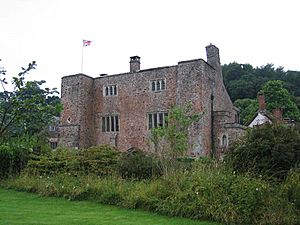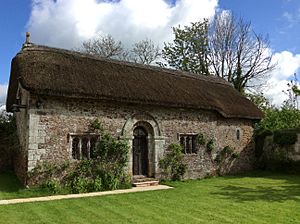Bickleigh Castle facts for kids
Quick facts for kids Bickleigh Castle |
|
|---|---|

Bickleigh Castle, Gatehouse
|
|
| Location | Bickleigh in Devon, England |
|
Listed Building – Grade I
|
|
| Official name: Bickleigh Castle Gatehouse | |
| Designated | 28 August 1987 |
| Reference no. | 1325638 |
|
Listed Building – Grade II*
|
|
| Official name: Bickleigh Castle chapel - including walls to enclosure to south and west | |
| Designated | 28 August 1987 |
| Reference no. | 1325639 |
|
Listed Building – Grade II*
|
|
| Official name: Old Court | |
| Designated | 24 October 1951 |
| Reference no. | 1106959 |
|
Listed Building – Grade II
|
|
| Official name: Bickleigh Castle, north range | |
| Designated | 28 August 1987 |
| Reference no. | 1170452 |
| Lua error in Module:Location_map at line 420: attempt to index field 'wikibase' (a nil value). | |
Bickleigh Castle is an old, strong house located right next to the River Exe in Bickleigh, Devon, England. It was once much bigger. Today, it is a collection of buildings from different time periods that together formed a water castle.
The main part of the castle was destroyed during the English Civil War. However, other buildings, mostly built around a central yard, survived. You can often visit the castle by making an appointment. It is mainly used for special events like weddings. The River Exe flows right through the castle grounds.
Contents
History of Bickleigh Castle
A very old Norman castle, built around the late 1000s or early 1100s, was taken down in the mid-1100s. During that time, a small stone chapel was built nearby. In the 1400s, the Courtenay family built a large house on the site. They used some of the older buildings in their new design. The Courtenay and Carew families lived there until the English Civil War. The Carews owned the estate until 1924.
During the English Civil War, which was a conflict between the King and Parliament, King Charles I's wife, Queen Henrietta Maria, stayed at the castle in 1644. She was a guest of Sir Henry and Lady Dorothy Carew on her way to Exeter. Soon after her visit, she gave birth to Princess Henrietta Anne Stuart in Exeter. Princess Henrietta later married the brother of King Louis XIV of France. There is a special plaque in Exeter that remembers her birth.
After the Queen's visit, Fairfax's Parliamentarian soldiers attacked the castle in late 1645. They had already damaged nearby Tiverton Castle. Most of Bickleigh Castle's strong parts were then torn down by the Parliamentarian troops. This was because the Carew family supported the King, and the castle was used as a strong base during the war.
After the war ended and the King was restored, a typical Devon farmhouse was added. It was made of cob (a natural building material) and had a thatched roof.
Over time, the buildings became run down and were used as a farm store and cottage. They were fixed up in the early 1900s. The old Norman chapel and a 12th-century gatehouse are still standing. So are the 15th-century Courthouse and parts of the original Norman outer wall. On a small hill behind the castle, hidden among plants, are the remains of an even older Saxon watchtower.
Buildings at Bickleigh Castle
The western part of the castle no longer exists. A building called the "Old Court" is south of the main courtyard. Most of the buildings, including the North range and gatehouse, were built around a central yard. The chapel is to the east, close to the River Exe. Moat Cottage is north of the other buildings.
The Gatehouse
The gatehouse was built in the early 1100s. It is a very important historic building, known as a Grade I listed building. It has three floors and a stone structure with a special roof. It also has small towers on top. A large archway in the middle leads into the courtyard. The Courtenay family changed the building a lot in the 1400s. It was then restored again in the 1920s and 1930s.
The Chapel
The oldest part of the chapel, called the Sanctuary, is even older than the Norman additions. The first written records of this building are from around AD 600. It was likely a chapel around AD 800. The Sanctuary is the oldest part and has been changed over time. There is proof that a wall with an arch once separated the Sanctuary from the main part of the chapel. This wall was removed when the chapel was made bigger. A wooden screen was put in its place. The current "wagon roof" is from the 1400s. This chapel is often said to be the oldest complete building in Devon. It was greatly fixed up in the early 1900s. Sadly, the wooden screen was lost in the 1800s when the chapel was used to keep cattle. The chapel now has a beautifully restored organ from 1884.
The Old Court
The Old Court is located south of the main courtyard. It was built in the mid-1400s. It was used as a court where important decisions were made. However, it has been changed and added to many times. Some parts of it might have been taken down. After the English Civil War, when the castle was badly damaged, it became a home. It is believed that a secret underground passage connects the Old Court to the Keep Gatehouse.
The North Range
The North Range was built in the late 1600s. It served as a farmhouse and housed staff for the owner, Sir Henry Carew. It is a two-story building with a thatched roof. In one room, there is a special carved fireplace mantel from the 1500s. The carving shows scenes related to the Reformation. It specifically shows the trial and execution of some important people in 1539. The carving also shows a picture of Exeter City and parts of Bickleigh Castle. King Henry VIII is also shown. Another part of the carving might show the Carew family's role in stopping a rebellion in 1549. This building was also restored in the 1930s. The carving was originally in a part of the castle that was destroyed during the Civil War. It was kept safe in Exeter Cathedral until the 1930s when it was returned and placed in its current spot.
Moat Cottage
Moat Cottage is located north of the other buildings. It was built in the late 1500s. It is a stone building with a thatched roof.
Stable Block
The old stable block, which also has a thatched roof, was rebuilt in the 1800s. It has a turret clock on top. Today, it has been changed into rooms for guests and reception areas.
Grounds of Bickleigh Castle
The castle is set in 60 acres of land. About 5 acres are beautifully landscaped gardens. The outer wall, gardens, and fish ponds in front of the Keep Gatehouse were designed in the 1700s. The ponds were made from what was left of the old Norman moat. The garden walls, gate posts, and gates are also considered historic listed buildings.
Bickleigh Castle Today
The castle was open to the public from 1970 to 1990, with many visitors each year. Today, you can visit Bickleigh Castle by making an appointment beforehand. Guided tours usually last about one hour.
The castle and its surrounding buildings are now mainly used for special weddings. They also host house parties, other events, and offer bed and breakfast stays.


